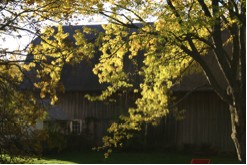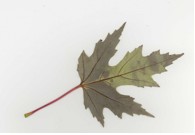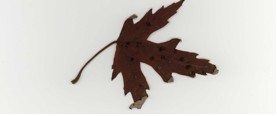"Silver Maple" "Soft Maple" "White Maple"
| From the Open Files of: | Northwest Synod of Wisconsin Resource Center |
| Contributed by: | Rev. Dr. Loretta Kuse & Dr. Hildegard Kuse |
| This file is available in: Word .doc, .rtf, Pictures available in .jpg 1,2,3 | |
Maple Family
"Silver Maple" "Soft Maple" "White Maple"
(Acer saccharinum)
God said, "See, I have given you every plant yielding seed that is upon the face of all the earth, and every tree with seed in its fruit; you shall have them for food. And to every beast of the earth, and to every bird of the air, and to everything that has the breath of life, I have given every green plant for food." And it was so. 31 God saw everything that he had made, and indeed, it was very good. And there was evening and there was morning, the sixth day. Genesis 1:29-31

If you are raking leaves under a tree that has bright yellow, sharply lobed leaves with deep notches it is likely that you are near a Silver Maple which is also sometimes called a Soft Maple, Water Maple, or White Maple. This is one of the most common shade trees in many communities.
While the Silver Maple is in the same family as the Sugar or Hard Maple from which maple syrup is made, its leaves in fall are more yellow-tan than the brilliant orange or red of those trees. It gets its name from the silvery underside of the green leaves in summer.

Silvery Underside of a Silver Maple Leaf
Sometimes if there has been a hard frost the leaves may turn brown and crumbly while they are still on the tree.
A close look at some of the fallen leaves may also tell what kinds of insects made their homes on the leaves during the summer.
Most of the blemishes do not damage the trees.

Maple Leaf with Insect Galls
As the leaves fall, some may come down on nearby flowerbeds where they should be left to serve as a blanket that keeps perennial plants from winter damage of alternate freezing and thawing.
Those that fall on the lawn can be raked up and transported to a compost pile to decay and become the best possible fertilizer for a garden. Some people like to rake the leaves onto a large sheet or tarp , pull up the corners and easily transport the leaves to a pile. Others like to place them into large plastic bags. Sometimes bags of leaves are placed around the foundations of a building such as a well house or chicken coop to add insulation. Some people place a handful of fertilizer into each bag. As the sun warms the bags, they heat up and the leaves decay more quickly into compost.
Some cities have leaf collection days where on appointed schedules leaves may be raked into the street near the curb to be picked up by city crews and transported to a central composting area. Children must be cautioned not to play in these leaf piles where they could be targets for traffic accidents.
Raking under a maple tree offers interesting views of the form and structure of the tree itself and an insight into the interdependence of trees and animals in nature.
• Can you find evidence of ways birds, insects and mammals have used the tree?
• Is there a row of small holes where a Yellow Bellied Sapsucker has drilled for
sap in the springtime or a larger hole where a Pileated Woodpecker has dug under the bark for insects?
• How might the branching pattern be important to the tree itself? Notice how the spreading branches allow space for each individual leaf to have a place in the sun so that it can use sunlight to manufacture food inside the leaves. (Photosynthesis)
• Are any birds using the tree during the time you are near it? Bluebirds and birds in the Flycatcher family use the spreading branches as convenient landing spots where they perch as they fly out to catch insects in the air. Baltimore Orioles may have selected the drooping branches as a convenient place to build their intricately woven pouch like nests. These nests sway in the winter winds while their builders have migrated to the tropics. Crows like to perch on a dead branch where they can get a ”birds eye view” of possible food sources.
• Are there dead branches in the tree? Because the tree is so fast growing, its wood is more brittle than that of most other maples. Sometimes large branches break off and leave gaping holes that permit fungus and insects to form a spot of decay in the wood.
• Are there tree roots near the surface of the soil? The tree is best not planted near the foundation of a home or near sidewalks because its roots may damage the concrete.
• Notice the buds on the bare branches. The new leaves and flowers appear in very early spring.
• How might squirrels use the tree? Are there holes in the tree where squirrels have a home? Can you observe squirrels sunning themselves or playing in the tree? In the late winter and early spring the new buds on the tree offer an important food supply for squirrels.
Heavenly Father: When you created your world you saw that it was good. Thank you for letting us see the wonderful ways in which plants and animals use your creation. Help us to care for it wisely. Amen
• Can you write your own poetry as you work outside in the leaves?
The Maple Tree
With dignity
The maple tree
Stands stately, firm, and tall.
Its shape and size
And changing skies
We love to watch them all.
With grace and poise
And swishing noise
The branches wave and bend.
In quiet ways
Throughout the days
Its colors change and blend.
A whirl of wings
A bird that sings
And shyly looks and flies
A swirl of fur
A squirrel says "Churr!"
They catch our watching eyes.
The things that crawl
Us too enthrall.
They look for food and place
To grow and change
Within its range
The tree gives home and space
Our maple tree
We'll watch and see
For bees that buzz and hum.
For changing sights
And great delights
Are surely soon to come!
Loretta Kuse
Loretta Kuse
Maple Leaves
If maple leaves
Could talk or sing
I wonder what they'd say.
Chattering first in early spring
The maple leaves
Are chattering in the breeze.
Are they weather watchers
Talking of a freeze?
They chatter as they flutter,
Somersault, and fly
From a lofty place
On a branch so high.
They rustle and they rattle,
Scoot and gently fly
They tussle and they battle,
As in the wind they cry.
They're moving, chasing,
Finding space to land
Chattering all together -
Isn't Autumn grand?"
- Loretta Kuse
[ LEAF RAKING DEVOTIONS ] • [ HOME ]
© Copyright 2005 by the Northwest Synod of Wisconsin
Resource Center.
Please see our usage
policy.
NW Synod of Wisconsin Resource Center